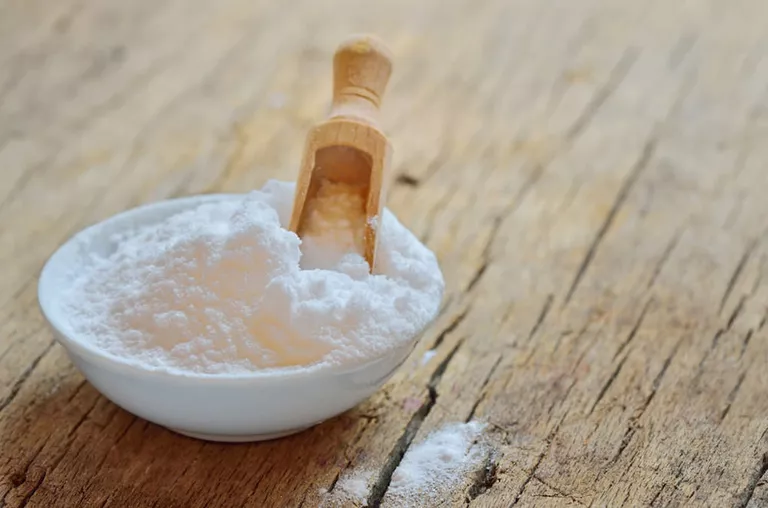The provenance of baking soda is rarely discussed, which leads to the question, 'Is this miracle substance really as eco-friendly as we think?'
If keeping a non-toxic, green home is a priority, then you’ve probably got a box of baking soda tucked away in a cupboard. Perhaps, like me, you’ve got multiple boxes – one in the kitchen, one in the bathroom, and one on the laundry shelf.
It seems that baking soda can be used for everything. It cleans homes, deodorizes furniture, exfoliates skin, kills mold, and polishes silver. I use it to wash my hair, to make deodorant, to take the stink out of sweaty gym clothes. We go through it at an astonishing rate, buying an extra-large box at least once a month.
While it’s great to have a single, all-natural ingredient that can replace so many other chemical-laden ones, with the added bonus of being able to buy it in a recyclable cardboard box (no plastic packaging, yay!), it only recently occurred to me that I didn’t know anything about where baking soda comes from. Is it sourced sustainably? Where and how is it made? Is it a finite resource that could run out, thanks to a generation of enthusiastic DIYers?
The Story Behind Baking Soda
An article on Grist recently addressed this topic, explaining how baking soda is mined. It comes out of the ground in the form of minerals nahcolite and trona, which are refined into soda ash (a.k.a. calcium carbonate), then turned into baking soda (a.k.a. sodium bicarbonate), among other things. Most of it comes from the United States, which contains the world’s largest trona deposit. There is no risk of depletion anytime soon:
“According to the U.S. Geological Survey, Wyoming alone contains 56 million tons of pure layered trona, plus 47 billion more tons mixed with other minerals. We’re only tapping trona at the rate of 15 million tons per year; the Wyoming Mining Association estimates that we have enough on hand to last more than 2,000 years.”
Nahcolite, a naturally occurring sodium bicarbonate, is often found in evaporated lake basins:
“[It exists] in large quantities in the central salt body of Searles Lake, California, and as concentrations up to 5 feet (1.5 metres) thick in oil shale deposits... in Colorado, where it is commercially mined. It also has been mined in Botswana and Kenya, and there are sizable deposits in Uganda, Turkey, and Mexico” (via Encyclopedia Britannica).
On its website, the Wyoming Mining Association explains how soda ash is currently used:
“Glassmaking consumes about half of the soda ash, followed by the chemical industry, which uses about a quarter of the output. Other uses include soap, paper manufacturing, and water treatment, and all baking soda comes from soda ash, which means you probably have a box of Wyoming trona product in your kitchen.”
Should We as Consumers Be Concerned About the Effects of Mining?
Apparently there are two ways to mine for trona. One is a ‘room-and-pillar’ method that involves carving out underground rooms supported by pillars. The mineral is scraped off the walls and removed by conveyor belt. The other is a liquid-injection method, where miners inject hot water underground to dissolve the minerals, pump out the liquid, and then evaporate the water to get at the leftover crystals. The mineral is then processed:
“The purification process begins with crushing the ore, which is then heated to drive off unwanted gases. This transforms the trona into a sodium carbonate. Water is added to this substance, which is then filtered to remove impurities. The water is evaporated and the resulting slurry is placed into a centrifuge to separate the remaining water from the soda ash crystals. The crystals are then sent to driers, screened, and sent to storage bins for transport.”
It’s undeniable that these methods are invasive and destructive, as any kind of mining would be. They use energy and emit toxic VOCs and methane. Trona processing in the U.S. generates air pollution, due to coal-powered facilities, and endangers the sage grouse’s habitat. In eastern Africa, soda ash processing plants have disturbed flamingo populations.
It’s far from ideal.
But when you consider that everything has a footprint on this earth and all products come with an intrinsic production cost – and that baking soda is capable of replacing countless other, much worse, lab-contrived substances in our daily lives – it remains a pretty decent option. In other words, you can go forward in your baking soda-fueled life without feeling terribly guilty.

















